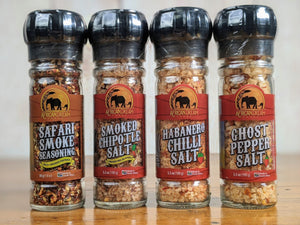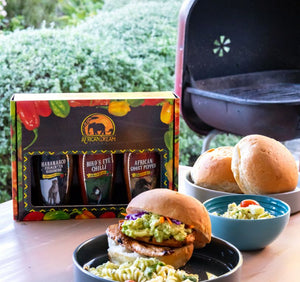The History of Hot Sauce
Jul 09, 2021
Hot sauce is absolutely everywhere nowadays. From Hot sauce festivals to TV shows to having “hot sauce in your bag swag” (Thank you, Beyoncé!) it’s surpassed mere condiment status and has become a genre of the zeitgeist. But why is hot sauce so popular and how did we get here? The history of hot sauce is fascinating and spans decades, continents, and cultures and that’s just scratching the surface.

The Origin Story
Who invented hot sauce, you ask? Unsurprisingly, the history of hot sauce traces back to the only place where chilies naturally occur—Central America. More specifically— the Aztecs. Chilli is believed to be one of the earliest plants cultivated by humans and archaeologists have found evidence of its use by the Aztecs as far back as 7000 BC. The first hot sauce in the world, most likely, consisted of ground-up chilies mixed with water and herbs. The Aztecs used it to enhance the flavor of their food, for medicinal purposes, to pay taxes, give tributes, and even as a weapon or punishment. So, if you’ve wondered whether hot sauce ever killed anyone, the answer may be yes.
Going Global

Fast forward a good few years and Columbus embarks on his infamous journey to find India. As per the request of the Spanish King and Queen, he was tasked with finding pepper (the black, grindable kind native to India). However, as we all know, Columbus didn’t dock in India and upon arrival in America, he was introduced to a pungent spicy fruit he called pepper. So, not only was he partly responsible for distributing chili peppers across Europe, but he also sort of named them.
However, just as Europeans were exposed to new foods and flavors, so were the native people. New ingredients like onions and garlic became key components in hot sauce reminiscent of our recipes today (like our Lemon and Garlic Peri-Peri sauce). Despite these advantages, the spice trade was controversial and brutal and the Habanero pepper, the main ingredient in our Habanasco -Fermented Habanero Hot Sauce, is considered a symbol of independence and self-determination by the Mayans who fought against complete Spanish rule.
Regionality

After it arrived in Europe, one of the first countries to customize chili peppers was Hungary. At the time Hungary was controlled by the Turks who were introduced to peppers from Arab and Indian traders. Hungarians loved the flavor but not the heat and so they removed the seeds, dried out the pepper and ground it into a fine powder called paprika—the key ingredient in our Safari Smoke Seasoning. To this day, Hungary is the only country in the world with the specific micro-climate needed to grow paprika peppers of the highest quality.
That being said, the Hungarians weren’t the only country to embrace and regionalize spice, and today every culture in the world has its own type of hot sauce and style of hot sauce. For instance, Peri-Peri made from the African Bird’s Eye Chilli originates from Mozambique. The sauce is popular in
Southern African cuisine and we also use it in our Bird’s Eye Chilli Sauce.
Hot sauce is so regionally particular that there are even spicy spelling discrepancies within the English language. Chili, Chilli, or Chile are all acceptable forms of the word depending on where you are. “Chili”, the American spelling, derives from the dish “Carne con chili” (meat with chili) now commonly referred to as “chili con carne” or just— “chili”.
Commercial Success
Hot sauce was first commercialized in 1807. According to newspaper ads of the time, a sauce called “cayenne sauce” was bottled and sold in Massachusetts, suggesting it might just be the oldest hot sauce in America. In the mid-1800’s a New York City company called J McCollik and Company produced a bird pepper sauce, probably not unlike what we know as bird’s eye chilli today. But the real pioneer of the hot sauce industry was Edmund McILhenny, inventor of Tabasco sauce. McILhenny grew his Tabasco peppers in Louisiana and sold his sauce at $1 a bottle. The sauce became a cultural phenomenon gaining its popularity in restaurants and hotels as a staple condiment. If you’re a fan of Tabasco, you’ll love our Jalanasco Fermented Jalapeno Sauce. It’s got that familiar vinegar tang but flavor-wise we’re in a league of our own.
In addition to the Tabasco craze, it was around this time that hot sauce became prevalent in home cooking. Hot sauce recipes first emerged in cookbooks around 1872. A recipe book called Mrs Hill's Cookbook, published by Annabella Hill contained a spicy BBQ sauce recipe that included red pepper and cayenne and a curry recipe that included homemade curry powder. Moreover, leading up to the 1900s, several hot sauce companies had emerged. These companies included Bergman’s Diablo Pepper Sauce who popularized the 5-inch-tall bottles with narrow necks that are still used today.
The Introduction of Scoville
By 1912, hot sauce was so widespread that a system was developed to keep track of spice levels. So, if you’ve ever wondered how they measure heat? The answer is Scoville. Wilbur Scoville invented the scale while in search of a heat-producing ointment. It was tested according to human taste buds and the idea was to dilute a spicy extract with water until it no longer tastes spicy. Every degree of dilution translates to a Scoville heat unit (SHU). For instance, 5000 cups of water dilute 1 cup of Tabasco sauce to the point of not being spicy at all.

However, if “how hot is too hot?” doesn’t apply to you, try our African Ghost Pepper sauce. It’s a 10/10 on the heat scale and no amount of Scoville dilution can take down this flavor punch. Just kidding, hot sauce remedies have been around just as long as hot sauce itself. One of the oldest ways to cool down your mouth was a swig of alcohol. Guess we’re not that different from our forefathers, after all.
Standing the Test of Time
Hot sauce’s prolific history begs a few questions: is hot sauce bad for you? Is Hot Sauce good for your health? And why do we love it as much as we do?
Thankfully, chilli is great for your health. Despite capsaicin (the active component in chilli) technically being a deterrent, humans love it and it loves us right back. Hot sauce is considered an anti-inflammatory and antioxidant. It is known to improve your metabolism and has been used in cold, sinus, and flu remedies for hundreds of years.
Good to know that thousands of years of consumption comes with benefits beyond flavor enhancement.
Loving hot sauce is entrenched in cultural norms, and centuries of complicated history but turns out it may also be about personality type. Research has shown that people with higher risk-seeking tendencies are more likely to enjoy spicy food. So, if you love roller-coasters or surfing you’re more likely to douse your fries in hot sauce than ketchup.
Today, hot sauce is found on every part of the globe and the average grocery store may have multiple aisles dedicated to the condiment. It’s been estimated that Americans buy over 50 million bottles of hot sauce a year and the global hot sauce market was worth USD 2.54 billion in 2020. It’s expected to reach USD 4.8 billion by 2028. Quite the success story for the humble (or feisty) chilli pepper that began native to only one region and African Dream Foods is proud to be a part of its story.




